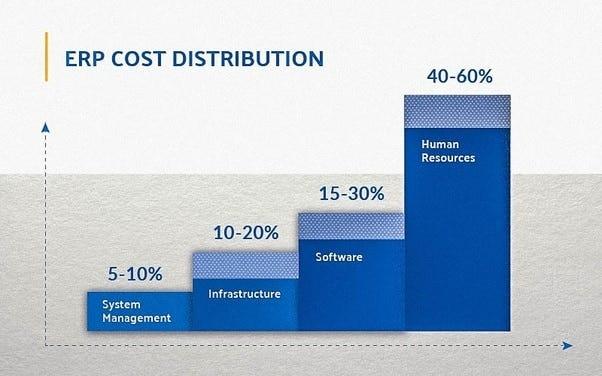The advantage of an enterprise resource planning (ERP) solution is that it can be tailored to each company's unique business needs. Not only does it handle specialized finance and accounting operations, the system also integrates information and operations related to human resources, customer relationship management, production and supply chain management. As a result of the differing needs, prices for ERP can also wildly differ — and no company wants to find out halfway through an ERP implementation that it doesn’t have the funds to finish the work.
To assist businesses in gaining a broader perspective and optimizing time and costs during deployment. In the content of the following article, we will consolidate all the necessary costs for ERP software deployment, enabling businesses to make informed decisions and save on their ERP implementation costs
I. ERP implementation costs
1. For large businesses
Due to complex organizational structures, extensive data requirements, and the need for powerful and scalable solutions, large enterprises often incur high implementation costs. In detail, large enterprises with multiple departments, branches, and subsidiaries necessitate integration into the ERP system, leading to a high number of users, potentially ranging from hundreds to thousands, with frequent access. As a result, the traditional small business pricing model is deemed suboptimal. Large enterprises often opt for full-ownership deployment of customized software, incurring a one-time installation and deployment fee, followed by regular software maintenance costs. Additionally, large enterprises typically require specialized support services and in-depth training, contributing to significantly high ERP software deployment fees.
2. For small and medium enterprises
The trend of deployment costs of ERP systems for small and medium-sized enterprises (SMEs) is toward lower costs compared to larger enterprises. As SMEs often have simpler processes, fewer users, and lower data volumes, resulting in reducing the complexity and deployment expenses. The deployment cost for small businesses ranges from $5,000 to $10,000, or they can opt for pre-packaged software with fees based on the number of users. If a business anticipates future growth, investing in a customized ERP system might be a more suitable and cost-effective option compared to using a pre-packaged software. Therefore, careful consideration is advised before deciding whether to use ERP software from a vendor or establish a custom system.
II. Key factors affecting ERP software development costs

1. Business Size
Businesses engaged in the trade of goods with a medium scale will require a more complex system compared to service-oriented companies. To select the best solution for your business, you must conduct a thorough analysis of the requirements. Even software providers cannot provide an accurate quote if you have not identified your system requirements.
2. Number of users
The more users will use the ERP system, the higher the development and deployment costs. Therefore, it is necessary to consider the number of users and their specific requirements when estimating the development costs of ERP software. Organizations should closely collaborate with ERP providers or implementation partners to determine the most accurate cost estimates based on their number of users and relevant factors.
3. Licence cost
License costs are also referred to as licensing fees when using ERP software. This license can be for a specific number of users, units, or the entire enterprise. And this license can be temporary or permanent, depending on the type of ERP system that the business implements.
4. ERP software maintenance and upgrade costs
After the deployment and warranty period of the ERP software, businesses need to consider maintenance and upgrade fees. Businesses often confuse the "support" responsibilities of solution providers, which include ensuring smooth system operation and fixing processes, integrating additional necessary applications. In reality, system maintenance and upgrades are two distinct items that need to be clearly separated.
5. Deployment type
Whether you choose cloud-based deployment or on-premise ERP implementation, each type has its own impact on software development costs. Most cloud-based ERP systems are sold on a per-user/per-month basis. On the contrary, On-Premise ERP systems require a large upfront fee, a one-time payment to become the system owner.
6. Training cost
Enterprise Resource Planning (ERP) is software that integrates many advanced functions. Employees within the company need to undergo training to operate the product effectively. Therefore, businesses need to consider this cost when budgeting for ERP deployment
III. Conclusion
The emergence and development of the ERP system is an essential requirement for the industrialization and automation process in all aspects of life. Any business needs to be prepared with resources and undertake digital transformation to better approach customers, optimize processes, and increase productivity. This way, businesses can enhance their competitive capabilities and achieve sustainable development goals.
For more details, businesses should immediately contact Sota Solutions for further advice!